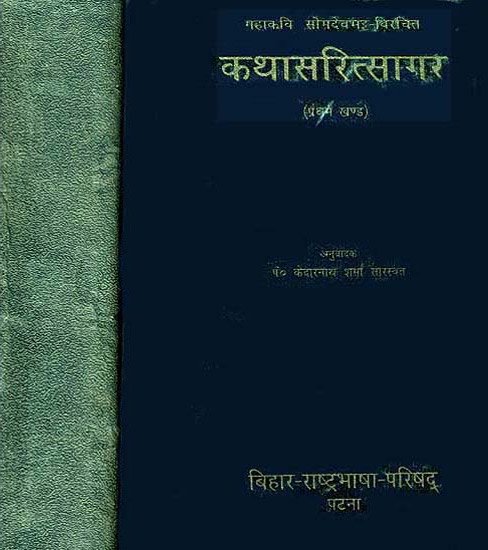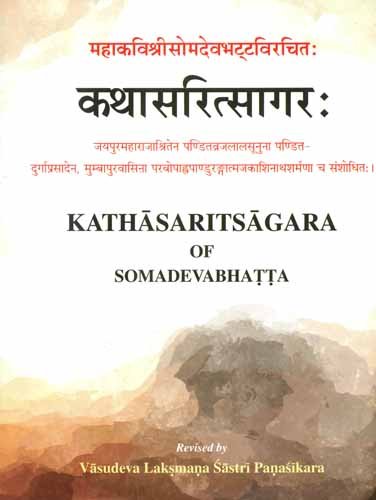Kathasaritsagara [sanskrit]
by C. H. Tawney | 2014 | 226,424 words | ISBN-13: 9789350501351
The Sanskrit edition of the Kathasaritsagara referencing the English translation and grammatical analysis. Written by Somadeva and dating from the 12th century, the Kathasaritsagara (or Katha-sarit-sagara) represents an epic legend narrating the adventures of Naravahanadatta as he strives to become the destined emperor of the Vidyadharas. Alternative titles: (Kathāsaritsāgara, कथासरित्सागर, Kathā-sarit-sāgara)
Verse 17.1.85
तयोस् तस्य समुत्तीर्णबाल्ययोर् उपनीतयोः ।
विप्रस्यादौ धनं क्षीणं सभार्यस्यायुषा ततः ॥ ८५ ॥
tayos tasya samuttīrṇabālyayor upanītayoḥ |
viprasyādau dhanaṃ kṣīṇaṃ sabhāryasyāyuṣā tataḥ || 85 ||
The English translation of Kathasaritsagara Verse 17.1.85 is contained in the book The Ocean of Story by C.H. Tawney. This book is available online or you could buy the latest edition:
Read online Buy now! The English translation by C.H. Tawney (2014)
Glossary of Sanskrit terms
Note: This extracts Sanskrit terms and links to English definitions from the glossary, based on an experimental segmentation of verse (17.1.85). Some terms could be superfluous while some might not be mentioned. Click on the word to show English definitions.
Tad, Samuttirna, Balya, Upanita, Vipra, Ada, Dhana, Kshina, Sabharya, Ayus, Tatah, Tata,
Analysis of Sanskrit grammar
Note: this is an experimental feature and only shows the first possible analysis of the Sanskrit text (Kathasaritsagara Verse 17.1.85). If the system was successful in segmenting the sentence, you will see of which words it is made up of, generally consisting of Nouns, Pronouns, Verbs, Participles and Indeclinables. Click on the link to show all possible derivations of the word.
- Line 1: “tayos tasya samuttīrṇabālyayor upanītayoḥ ”
- tayos -
-
ta (noun, masculine)[genitive dual], [locative dual]ta (noun, neuter)[genitive dual], [locative dual]tā (noun, feminine)[genitive dual], [locative dual]tad (noun, neuter)[genitive dual], [locative dual]sa (noun, masculine)[genitive dual], [locative dual]sā (noun, feminine)[genitive dual], [locative dual]
- tasya -
-
√tas -> tasya (absolutive)[absolutive from √tas]ta (noun, masculine)[genitive single]ta (noun, neuter)[genitive single]tad (noun, neuter)[genitive single]sa (noun, masculine)[genitive single]√tas (verb class 4)[imperative active second single]
- samuttīrṇa -
-
samuttīrṇa (noun, masculine)[compound], [vocative single]samuttīrṇa (noun, neuter)[compound], [vocative single]
- bālyayor -
-
bālya (noun, neuter)[genitive dual], [locative dual]
- upanītayoḥ -
-
upanīta (noun, masculine)[genitive dual], [locative dual]upanīta (noun, neuter)[genitive dual], [locative dual]upanītā (noun, feminine)[genitive dual], [locative dual]
- Line 2: “viprasyādau dhanaṃ kṣīṇaṃ sabhāryasyāyuṣā tataḥ ”
- viprasyā -
-
vipra (noun, masculine)[genitive single]vipra (noun, neuter)[genitive single]
- adau -
-
ada (noun, masculine)[nominative dual], [vocative dual], [accusative dual]ad (noun, masculine)[nominative dual], [vocative dual], [accusative dual]
- dhanam -
-
dhana (noun, masculine)[adverb], [accusative single]dhana (noun, neuter)[adverb], [nominative single], [accusative single]
- kṣīṇam -
-
kṣīṇa (noun, masculine)[adverb], [accusative single]kṣīṇa (noun, neuter)[adverb], [nominative single], [accusative single]kṣīṇā (noun, feminine)[adverb]√kṣī -> kṣīṇa (participle, masculine)[accusative single from √kṣī class 1 verb], [accusative single from √kṣī class 5 verb], [accusative single from √kṣī class 9 verb]√kṣī -> kṣīṇa (participle, neuter)[nominative single from √kṣī class 1 verb], [accusative single from √kṣī class 1 verb], [nominative single from √kṣī class 5 verb], [accusative single from √kṣī class 5 verb], [nominative single from √kṣī class 9 verb], [accusative single from √kṣī class 9 verb]
- sabhāryasyā -
-
sabhārya (noun, masculine)[genitive single]sabhārya (noun, neuter)[genitive single]
- āyuṣā -
-
āyus (noun, masculine)[instrumental single]āyus (noun, neuter)[instrumental single]
- tataḥ -
-
tataḥ (indeclinable adverb)[indeclinable adverb]tataḥ (indeclinable correlative)[indeclinable correlative]tataḥ (indeclinable)[indeclinable]tad (noun, neuter)[ablative single], [ablative dual], [ablative plural]tata (noun, masculine)[nominative single]√tan -> tata (participle, masculine)[nominative single from √tan class 8 verb]sa (noun, masculine)[ablative single], [ablative dual], [ablative plural]sā (noun, feminine)[ablative single], [ablative dual], [ablative plural]
Other editions:
Also see the following editions of the Sanskrit text or (alternative) English translations of the Kathasaritsagara Verse 17.1.85
Kathasaritsagar
by Kedarnath Sharma Saraswat (2005)
The Only Edition with the Sanskrit Text and its Hindi Translation (An Old and Rare Book) Set of 3 Vol.
Buy now!
Kathasaritsagara of Somadeva Bhatta (Sanskrit Text Only)
by Vasudeva Laksmana Sastri (2013)
Katha Sarit Sagar in Marathi
by H. A Bhave (1995)
Set of 5 Volumes; Published by Varada Books, Pune. 2256 pages (Throughout B/W Illustrations).
Buy now!
Katha Sarit Sagara (Tamil)
by S. V. Ganapati (எஸ். வி. கணபதி) (2014)
[கதா சரித் சாகரம்] Published by Alliance Publications.
Buy now!
Galpa Shono
by Abhijit Chattopadhyay (2014)
[গল্প শোনো] Galpa Shono: Bengali Translation of 'Suno Kahani From Katha Sarit Sagar'; 9788126015436; Published by Sahitya Akademi, Delhi.
Buy now!Preview of verse 17.1.85 in Bengali sript:
তযোস্ তস্য সমুত্তীর্ণবাল্যযোর্ উপনীতযোঃ ।
বিপ্রস্যাদৌ ধনং ক্ষীণং সভার্যস্যাযুষা ততঃ ॥ ৮৫ ॥
![Kathasaritsagara [sanskrit] - book cover](/uploads/a/Katha-Sarit-Sagara.jpg)




